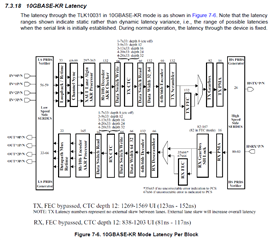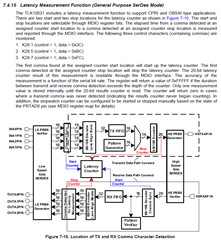Tool/software:
Dear team,
Is it possible to perform a latency measurement when the TLK10031 works in 10Base-KR mode (without link training and without AutoNeg)?
If so, will be glad to get an high-level instruction how to do this.
This thread has been locked.
If you have a related question, please click the "Ask a related question" button in the top right corner. The newly created question will be automatically linked to this question.
Tool/software:
Dear team,
Is it possible to perform a latency measurement when the TLK10031 works in 10Base-KR mode (without link training and without AutoNeg)?
If so, will be glad to get an high-level instruction how to do this.
Hi Adrian,
Latency measurements are provided in the datasheet.

Best,
Lucas
Thanks Lucas,
The question was about active measurement to determine the latency of the data-path every data-path bring-up, similar to what is described in the data-sheet for the general purpose SerDes mode (paragraph 7.4.15 - figure below). There, it is described that there is a latency measurement function, with start and stop locations and a latency counter, and this functionality does not appear in the 10Base-KR mode on DS. I just wanted to make sure if an active latency measurement is supported (or not) in 10Base-KR mode.
Thank you.

Hi Adrian,
Thank you for the clarification.
I'm not super familiar with the latency measurement function as I haven't used it myself. According to the datasheet, the latency measurement function can only be used in general purpose SerDes mode when operating at one of the serial rates specified in the CPRI/OSAI specifications. Therefore I don't believe latency can be measured internally in 10G-KR mode.
Figure 7-6 can be used for device latency specifications in 10G-KR mode.
Best,
Lucas